 |
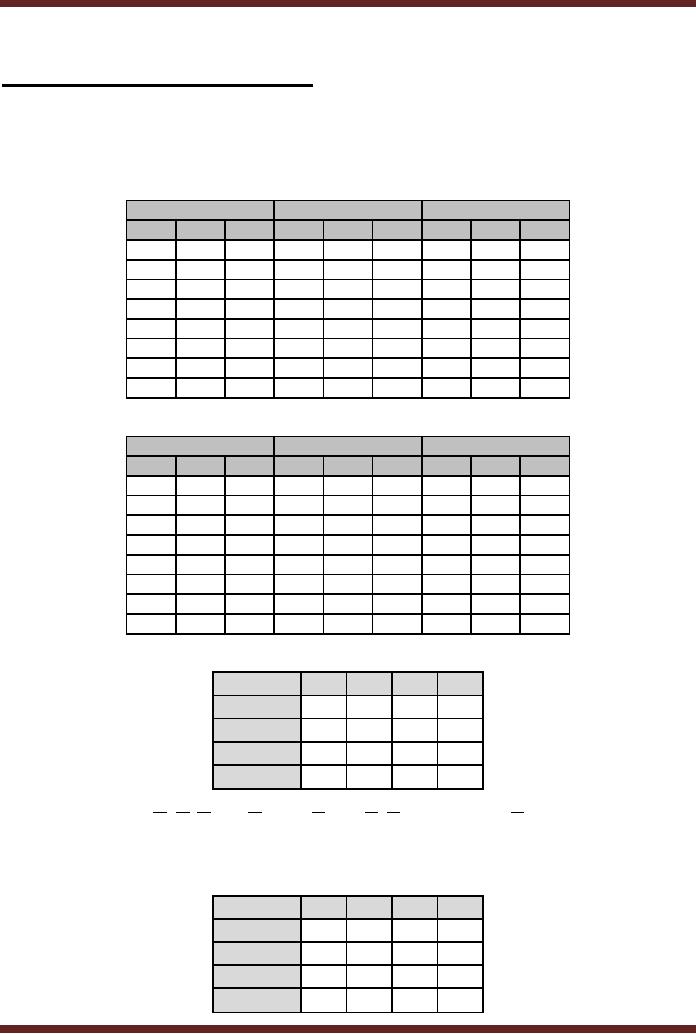
CS302 -
Digital Logic & Design
Lesson
No. 36
EXAMPLE4:
3-BIT UP/DOWN
COUNTER
The
3-bit Up/Down Counter was
earlier implemented using
J-K flip-flops. A D
flip-flop
based
3-bit Up/Down Counter is
implemented by mapping the
present state and next
state
information in D
Input table. Table 36.1.
The Karnaugh maps and
the simplified
Boolean
expressions
derived from the D Input
table, table 36.2 are
used to implement the
3-bit
Up/Down
counter circuit. Figure
36.1
Present
State
Next
State X=0
D flip-flop
inputs
Q2
Q1
Q0
Q2
Q1
Q0
D2
D1
D0
0
0
0
0
0
1
0
0
1
0
0
1
0
1
0
0
1
0
0
1
0
0
1
1
0
1
1
0
1
1
1
0
0
1
0
0
1
0
0
1
0
1
1
0
1
1
0
1
1
1
0
1
1
0
1
1
0
1
1
1
1
1
1
1
1
1
0
0
0
0
0
0
Table
36.1a
D flip-flop
input table for
X=0
Present
State
Next
State X=1
D flip-flop
inputs
Q2
Q1
Q0
Q2
Q1
Q0
D2
D1
D0
0
0
0
1
1
1
1
1
1
0
0
1
0
0
0
0
0
0
0
1
0
0
0
1
0
0
1
0
1
1
0
1
0
0
1
0
1
0
0
0
1
1
0
1
1
1
0
1
1
0
0
1
0
0
1
1
0
1
0
1
1
0
1
1
1
1
1
1
0
1
1
0
Table
36.1b
D flip-flop
input table for
X=1
Q2Q1/Q0X
00
01
11
10
00
0
1
0
0
01
0
0
0
1
11
1
1
1
0
10
1
0
1
1
D 2 = Q 2 Q1 Q 0 X + Q 2Q1Q 0 X + Q 2 Q 0 X + Q 2Q1 X + Q 2 Q1Q 0
Table
36.2a
Boolean
expression for D2 inputs
Q2Q1/Q0X
00
01
11
10
00
0
1
0
1
01
1
0
1
0
11
1
0
1
0
10
0
1
0
1
367
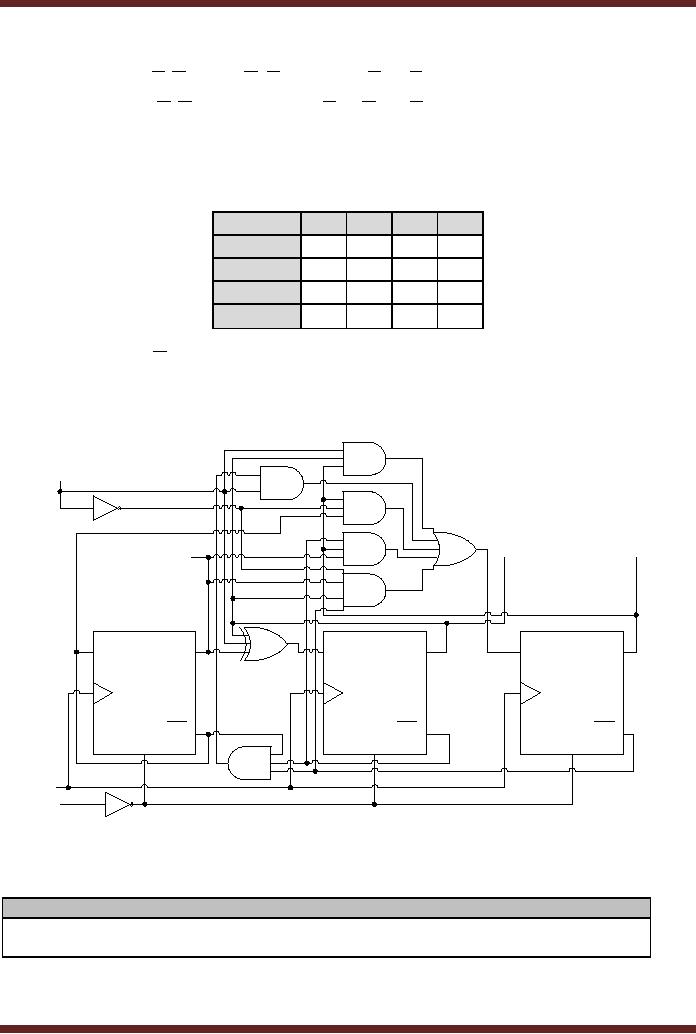
CS302 -
Digital Logic & Design
D1 = Q1 Q 0 X + Q1 Q 0 X + Q1Q 0 X + Q1Q 0 X
D1 = (Q1 Q 0 + Q1Q 0 )X + (Q1 Q 0 + Q1Q 0 )X
D1 = Q 0 ⊕Q1 ⊕ X
Table
36.2b
Boolean
expression for D1 inputs
Q2Q1/Q0X
00
01
11
10
00
1
1
0
0
01
1
1
0
0
11
1
1
0
0
10
1
1
0
0
D0 = Q0
Table
36.2c
Boolean
expression for D0 inputs
X=0
(up)
X=1
(down)
Q1
Q2
Q0
SET
SET
SET
D
D
D
Q
Q
Q
flip-flop
2
flip-flop
1
flip-flop
3
Q
Q
Q
CLR
CLR
CLR
CLK
Clear
Figure
36.1 3-bit Up/Down
Counter
The
main definitions and
declarations of the ABEL
input file for the
Up/Down Counter is
shown.
Table 36.3.
Pin
Definition
CLOCK,
CLEAR, X
pin 1, 2,
3;
Q0,
Q1, Q2
pin
21, 22, 23 ISTYPE
`reg,buffer';
Table
36.3a
Input/Output
Pin Definition of 3-bit
Up/Down Counter
368
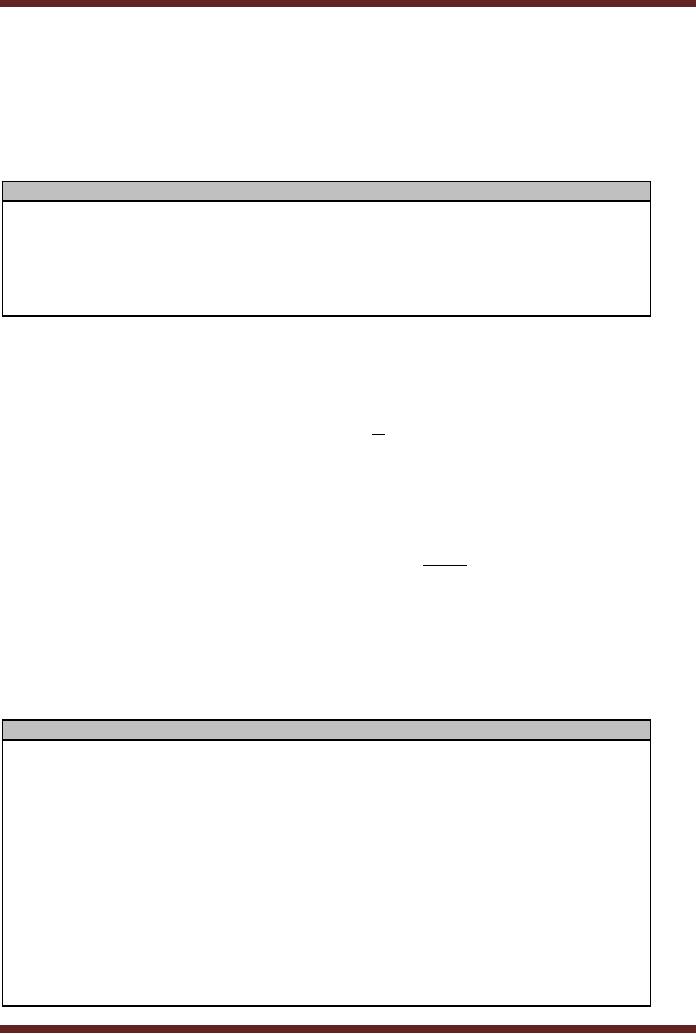
CS302 -
Digital Logic & Design
The
Clock, Clear and X input
variables applied at pins 1, 2
and 3 are used to provide
the clock
signal,
the asynchronous clear pulse
and the external input to
control the direction of the
count
sequence.
The Q0, Q1 and Q2 outputs
are available from the D
flip-flops of the three
OLMCs
at pins
21, 22 and 23. Since
these outputs are sequential
outputs available from the
flip-flops
therefore
they are defined of type
register `reg.buffer'. The
three outputs are the
State
variables
that define the different
states. Table 36.3a
Equations
Q0 :=
!Q0;
Q1 := Q0 $ Q1 $
X;
Q2 := !Q2 &
!Q1 & !Q0 & X # !Q2 & Q1
& Q0 & !X # Q2 & !Q0 & !X
# Q2 & Q1 & X # Q2
& !Q1 & Q0;
[Q0,
Q1, Q2].CLK = clock;
[Q0,
Q1, Q2].AR = !clear;
Table
36.3b
Equation
Definition of 3-bit Up/Down
Counter
The
ABEL Equations definition
defines the Next state
outputs for the three
state variables. The
ABEL
assignment equations represent
the Boolean expressions
derived for the three D
flip-
flop
inputs, table 36.2. Thus
the next state output
for variable Q0 depends upon
the D0 input
which is
defined by the Boolean
expression as Q
0 . Similarly,
for the next state
output for
variable Q1
depends upon the D1 input
which is defined by the
Boolean expression
as Q 0 ⊕Q1 ⊕ X . The ABEL
next state expression for
state variable Q3 is similarly
based on the
Boolean
expression for Q3.
The
ABEL statements [Q0, Q1,
Q2].CLK = clock and [Q0,
Q1, Q2].AR = !clear
declare
the
change from the present
state to the next state on a
clock transition and the
Asynchronous
reset
(AR) of all the three D
flip-flops in the OLMC by
the Clear input signal. Table
36.3b
The
Test Vector definition
defines the test vectors
for all the three
counter inputs and
the
three counter outputs. Since
the Asynchronous input
overrides the Synchronous X
input,
therefore in
the first test vector
when the Clear Asynchronous
input is 0 the output is
cleared to
000
irrespective of the X Synchronous
input. When the Clear
input is set to 1, the
counter
functions
normally, the X input set to
0 sets the counter to
increment and the X input
set to 1
sets
the counter to decrement.
Table 36.3c
Test
Vector
([Clock,
Clear, X] -> [Q2, Q1,
Q0])
[ .c. , 0
,.x.] -> [0 , 0 , 0 ];
[ .c. , 1
, 0 ] -> [0 , 0 , 1 ];
[ .c. , 1
, 0 ] -> [0 , 1 , 0 ];
[ .c. , 1
, 0 ] -> [0 , 1 , 1 ];
[ .c. , 1
, 0 ] -> [1 , 0 , 0 ];
[ .c. , 1
, 0 ] -> [1 , 0 , 1 ];
[ .c. , 1
, 0 ] -> [1 , 1 , 0 ];
[ .c. , 1
, 0 ] -> [1 , 1 , 1 ];
[ .c. , 1
, 0 ] -> [0 , 0 , 0 ];
[ .c. , 1
, 1 ] -> [1 , 1 , 1 ];
[ .c. , 1
, 1 ] -> [1 , 1 , 0 ];
[ .c. , 1
, 1 ] -> [1 , 0 , 1 ];
[ .c. , 1
, 1 ] -> [1 , 0 , 0 ];
369
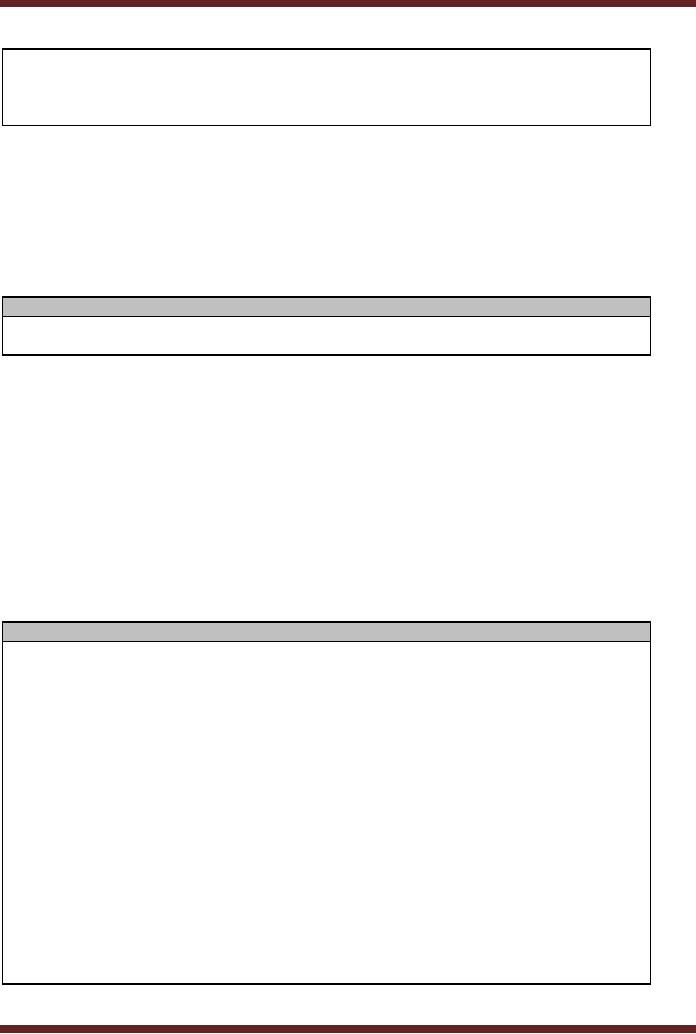
CS302 -
Digital Logic & Design
[
.c.
,
1
, 1 ] ->
[0
,
1
,
1 ];
[
.c.
,
1
, 1 ] ->
[0
,
1
,
0 ];
[
.c.
,
1
, 1 ] ->
[0
,
0
,
1 ];
[
.c.
,
1
, 1 ] ->
[0
,
0
,
0 ];
Table
36.3c Test Vector Definition
of 3-bit Up/Down
Counter
Using a
Truth-Table to specify Sequential
Circuit
The
ABEL Input file can
use a truth table instead of
the equation to specify the
Boolean
expressions.
The Equation definition of
the ABEL input file
reduces to the two
statements
defining
the change in the output
state based on the clock
transition and the
Asynchronous
reset of
the D flip-flops through the
Asynchronous Clear signal.
Table 36.4a.
Equations
[Q0,
Q1, Q2].CLK = clock;
[Q0,
Q1, Q2].AR = !clear;
Table
36.4a
Equation
Definition for Truth Table
based Sequential Circuit
definition
The
3-bit Up/Down Sequential
circuit's complete operation
can be described by a truth
table
which
has external inputs Clear, X
and Present State variables
Q0, Q1 and Q2. The
output of
the
counter circuit are the
Next State variables Q0,
Q1, Q2. The first
statement of the
truth
table
definition indicates that
when Clear is set to 0, the
counter output is reset to
000
irrespective of
the X input and the
present state inputs. The
next 16 statements define
the 8
input
combinations and the
corresponding counter outputs
when the counter is counting
up
and
the 8 input combinations and
its corresponding outputs
when the counter is
counting
down.
Table 36.4b.
Truth
Table
Truth_Table
([Clear, X,
Q2, Q1, Q0] :> [Q2,
Q1, Q0])
[ 0 ,.x.,
.x. , .x. , .x. ] :> [ 0 , 0 , 0
];
[ 1 , 0 , 0 , 0 , 0 ]
:> [ 0 , 0 , 1 ];
[ 1 , 0 , 0 , 0 , 1 ]
:> [ 0 , 1 , 0 ];
[ 1 , 0 , 0 , 1 , 0 ]
:> [ 0 , 1 , 1 ];
[ 1 , 0 , 0 , 1 , 1 ]
:> [ 1 , 0 , 0 ];
[ 1 , 0 , 1 , 0 , 0 ]
:> [ 1 , 0 , 1 ];
[ 1 , 0 , 1 , 0 , 1 ]
:> [ 1 , 1 , 0 ];
[ 1 , 0 , 1 , 1 , 0 ]
:> [ 1 , 1 , 1 ];
[ 1 , 0 , 1 , 1 , 1 ]
:> [ 0 , 0 , 0 ];
[ 1 , 1 , 0 , 0 , 0 ]
:> [ 1 , 1 , 1 ];
[ 1 , 1 , 1 , 1 , 1 ]
:> [ 1 , 1 , 0 ];
[ 1 , 1 , 1 , 1 , 0 ]
:> [ 1 , 0 , 1 ];
[ 1 , 1 , 1 , 0 , 1 ]
:> [ 1 , 0 , 0 ];
[ 1 , 1 , 1 , 0 , 0 ]
:> [ 0 , 1 , 1 ];
[ 1 , 1 , 0 , 1 , 1 ]
:> [ 0 , 1 , 0 ];
[ 1 , 1 , 0 , 1 , 0 ]
:> [ 0 , 0 , 1 ];
[ 1 , 1 , 0 , 0 , 1 ]
:> [ 0 , 0 , 0 ];
Table
36.4b
Truth
Table definition for the
3-bit Up/Down Counter
370
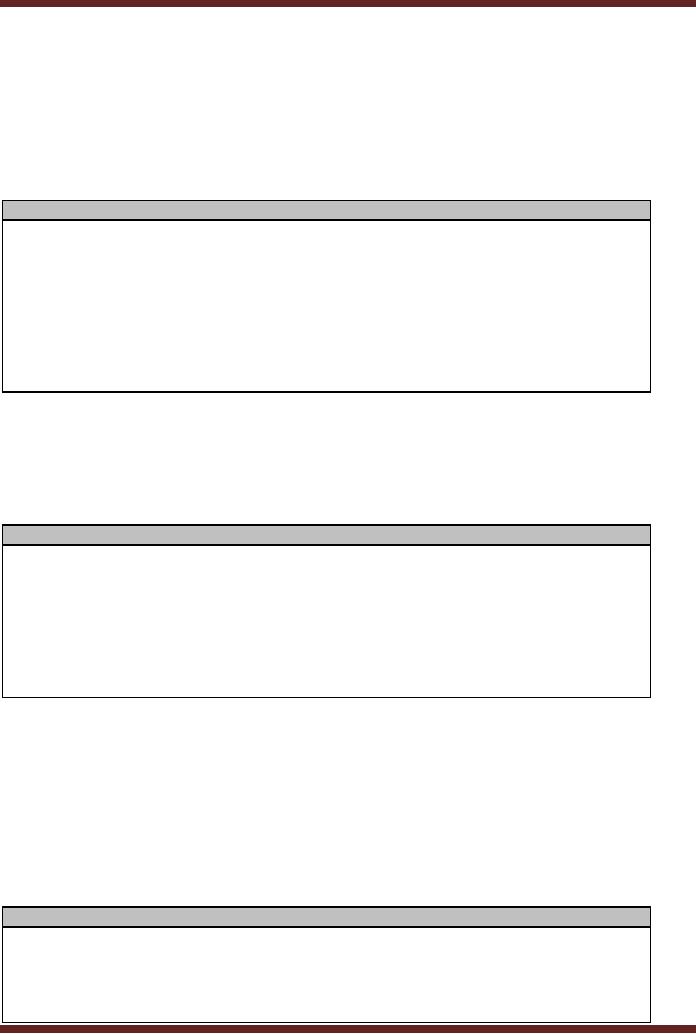
CS302 -
Digital Logic & Design
Using a
State Diagram to specify
Sequential Circuit
The
ABEL Input file can
also use a State diagram to
specify the states of the
Sequential
circuit.
Before specifying the State
diagram, the states have to
be defined. After defining
the
states
the state diagram is defined
by indicating how the
present state changes to the
next
state.
ABEL, IF-THEN-ELSE statements or
GOTO statements are used to
specify the how
the
present
state changes to the next
state.
State
Definition
QSTATE
= [Q2,
Q1, Q0];
A
= [ 0 , 0 , 0
];
B
= [ 0 , 0 , 1
];
C
= [ 0 , 1 , 0
];
D
= [ 0 , 1 , 1
];
E
= [ 1 , 0 , 0
];
F
= [ 1 , 0 , 1
];
G
= [ 1 , 1 , 0
];
H
= [ 1 , 1 , 1
];
Table
36.5a
State
definition of the 3-bit
Up/Down Counter
The
QSTATE variable defines the
eight states of the counter
circuit. Each state defined
by the
three
state variables is identified by
state names A, B to H. Table
36.5a.
State
Diagram
State
A:
if X then H
else B;
State
B:
if X then A
else C;
State
C:
if X then B
else D;
State
D:
if X then C
else E;
State
E:
if X then D
else F;
State
F:
if X then E
else G;
State
G:
if X then F
else H;
State
H:
if X then G
else A;
Table
36.5b
Defining
the next states using
IF-THEN-ELSE
The
ABEL, IF-THEN-ELSE statements
are used to define the
input conditions for which
the
present
state changes to the next
state. For example, in the
State Diagram, the State
A
changes to
state H if the input
variable X=1 otherwise the
next state is state B.
Similar, if then
else
statements are used to
define the next states
for each of the present
states. If the
present
state
switches to the next state
without checking any
conditions then an ABEL,
GOTO
statement is
used. For example, for a
3-bit Up counter GOTO
statements are used to
specify
the
next state without checking
any condition. Table
36.5c
State
Diagram
State
A:
GOTO
B;
State
B:
GOTO
C;
State
C:
GOTO
D;
State
D:
GOTO
E;
State
E:
GOTO
F;
371

CS302 -
Digital Logic & Design
State
F:
GOTO
G;
State
G:
GOTO
H;
State
H:
GOTO
A;
Table
36.5c
Defining
the next states using
GOTO
The
ABEL Input file which
uses the State diagram
instead of equations or the
truth table
replaces
the Equation part by State
Definitions and State
Diagram. The Equation
definition
only
defines the change in state
on a clock transition and
the Asynchronous input as
shown in
table
36.4a
Design
Example: Elevator Control
System
An elevator is
installed in a building that
moves from one floor to
the other. A person
going to
the second floor from
the first floor presses a
request button on the first
floor. When
the
elevator arrives at the
first floor, the doors
open and the person
walks in to the
elevator.
The
person presses the request
button for the second
floor. When the elevator
reaches the
second
floor, it stops and the
doors open. The doors
are opened for a specified
time. A person
inside
the elevator can keep
the doors open for a
longer duration of time if an
`Open' button is
pressed.
Inside the elevator and
outside near each entrance
to the elevator there is a
7-
segment
display which displays the
floor on which the elevator
currently is. The direction,
Up
or Down in
which the elevator is moving
is also displayed.
Input
and Output
Signals
Different
inputs and outputs are
required to control the
operation of the elevator.
The
operation of
the elevator is based on a
sequential state machine. A
State diagram
describes
all
the operations of the
elevator. The inputs that
are received from the
person in the form of
requests
are
�
Request
buttons to call the
elevator, REQ1 and
REQ2
�
Floor
request buttons inside the
elevator, FLOOR1 and
FLOOR2
�
Open
door button, OPEN
The
duration for which the
elevator doors are opened,
and remain open, and
the time it takes
for
the elevator to move form
one floor to the next is
determined by a clock signal.
When the
elevator
arrives at a floor a floor
sensor generates an ARRIVE
signal. Thus the State
machine
uses to
additional input
signals.
�
Clock
signal, CLOCK
�
Arrive
signal, ARRIVE
The
elevator generates three
output signals to indicate
the doors OPEN/CLOSED,
direction of
movement of
elevator UP/DOWN and the
motion of the elevator
WAITING/MOVING.
�
Door
Open/Close, DOOR=0 and
DOOR=1
�
Direction
Up/Down, DIR=0 and
DIR=1
�
Motion
Waiting /Moving, MOTION=0
and MOTION=1
In addition to
the three output signals
the elevator generates
signals to display the
floor
number
and the direction in which
the elevator is
moving.
372
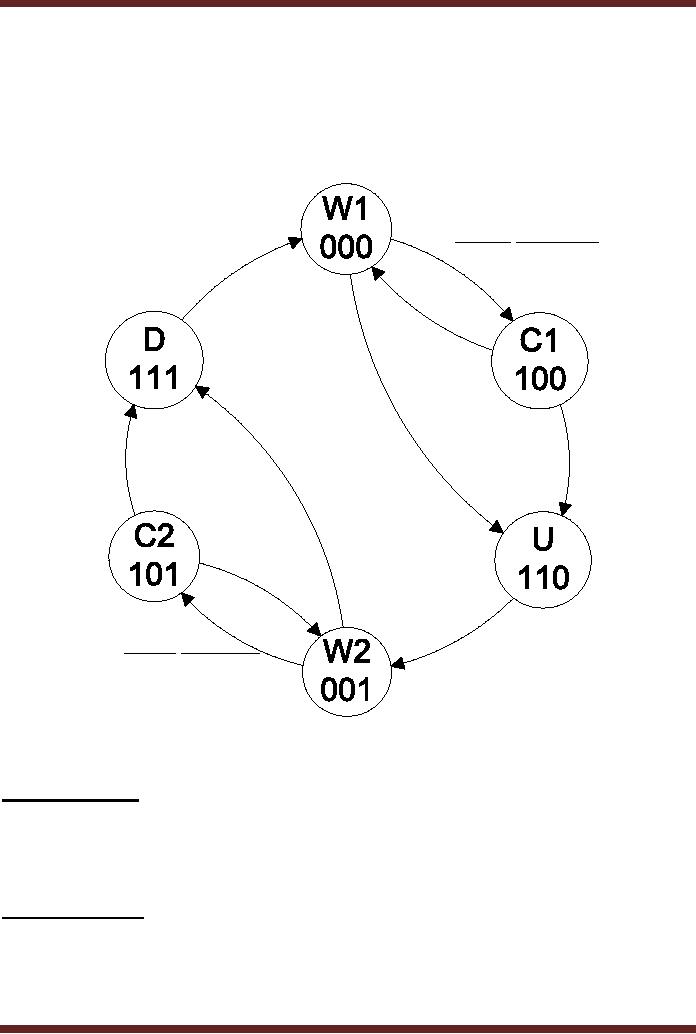
CS302 -
Digital Logic & Design
Elevator
State Diagram
The
State diagram of the
elevator operation has six
states. Figure 36.2. Three
state variables
are
required to define the six
states. The state outputs
directly determine the
status of the
door,
the direction of the motion
and control the
motion.
REQ2.FLOOR2
ARRIVE
REQ1 + OPEN
REQ2 + FLOOR2
REQ1 + FLOOR1
REQ2 + FLOOR2
REQ1 + FLOOR1
REQ2 + OPEN
ARRIVE
REQ1.FLOOR1
Figure
36.2
State
Diagram of Elevator
Wait 1
State (W1): The initial
state of the elevator is the
Wait 1 State (W1), where
the elevator
is waiting on
the first floor with
the door open. The W1
state 000 identifies the
state outputs.
� Door=0
(open)
� Motion=0
(waiting)
� Dir=0
(up)
Close 1
State (C1): If for a fixed
interval of time, a request
from second floor is not
received or
the
button for floor 2 is not
pressed, the system goes to
state Close1 (C1). In this
state the
elevator
remains on the first floor
with its doors closed.
The C1 state 100 identifies
the output
signals.
� Door=1
(close)
� Motion=0
(waiting)
373
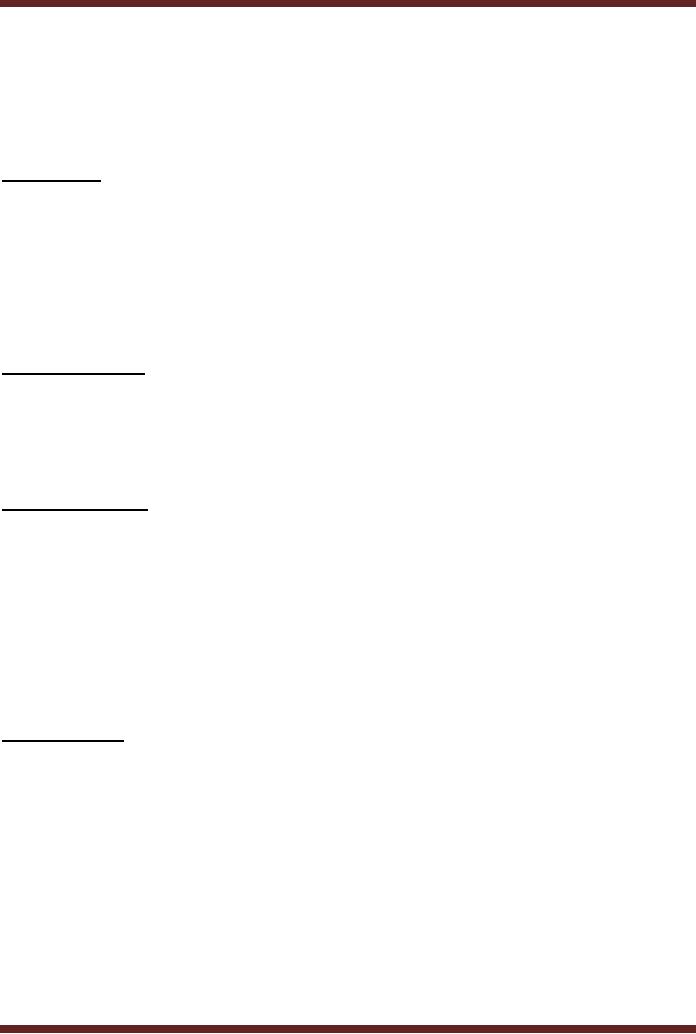
CS302 -
Digital Logic & Design
�
Dir=0
(up)
If at any
time a person inside the
elevator presses the Open
door switch, OPEN or
a
person
waiting on first floor
requests for the elevator
REQ1, the system switches
back to Wait
1 State,
W1.
Up State
(U): The system switches to
Up state (U) when either a
request is received from
the
second
floor REQ2 or a person
presses the Floor2 switch
F2. The U State represents
the state
when
the elevator is moving up.
The outputs of this state
are 110.
� Door=1
(close)
� Motion=1
(moving)
� Dir=0
(up)
Similarly
when the system is in state
W1, the system switches to
Up state (U), when either
a
request is
received from the second
floor REQ2 or a person
presses the Floor2 switch
F2.
Wait 2
State (W2): The system
switches from Up state (U),
to Wait 2 state (W2) when
the
Arrive
signal is received from the
floor sensor. In the W2
state the elevator is
waiting on floor 2
with
its door open. The
output of the W2 state are
001
� Door=0
(open)
� Motion=0
(waiting)
� Dir=1
(down)
Close 2
State (C2): The elevator
waits with its door
open on the second floor
for a specified
period of
time. If a request from
first floor is not received
or the button for floor 1 is
not
pressed,
the system switches to
Close2 state (C2). In this
state the elevator remains
on the
second
floor with its doors
close. The output signals of
C2 state are 101
� Door=1
(close)
� Motion=0
(waiting)
� Dir=1
(down)
If at any
time a person inside the
elevator presses the Open
door switch, OPEN or
a
person
waiting on second floor
requests for the elevator
REQ2, the system switches
back to
Wait 2
State, W2.
Down
State (D): The system
switches to Down state (D),
when either a request is
received
from
the first floor REQ1 or a
person presses the Floor1
switch F1. The D, Down
represents
the
state when the elevator is
moving down. The outputs of
this state are
111.
� Door=1
(close)
� Motion=1
(moving)
� Dir=1
(down)
Similarly
when the system is in state
W2, the system switches to
state D, Down when either
a
request is
received from the first
floor REQ1 or a person
presses the Floor1 switch
F1.The
system
switches to the Wait 1 state
(W1) when the Arrive
signal is received from the
floor
sensor on
the first floor.
374
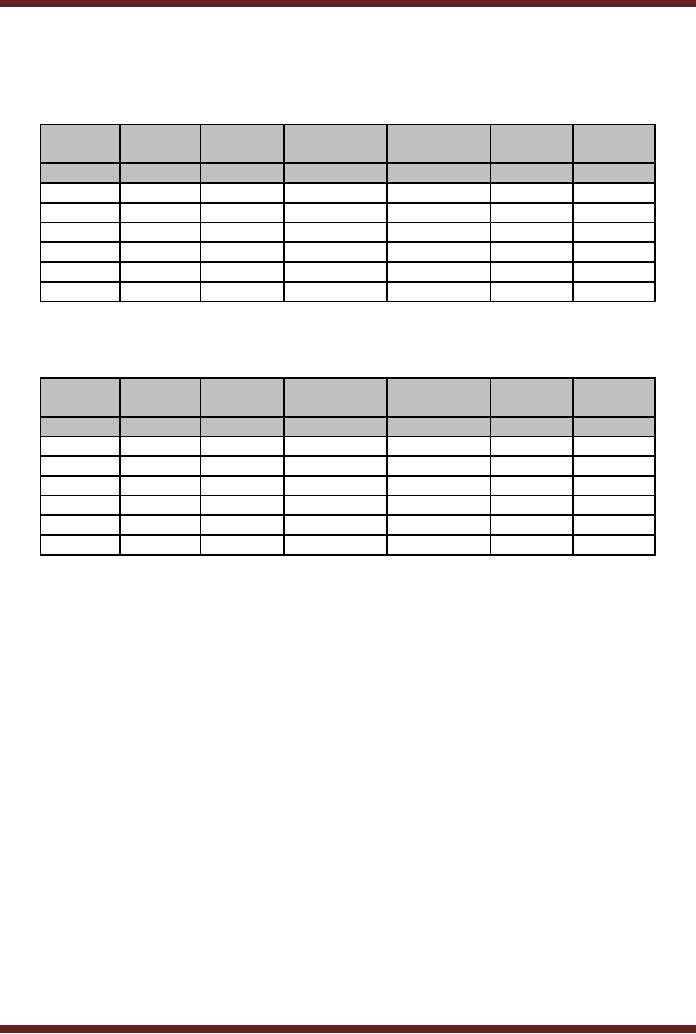
CS302 -
Digital Logic & Design
State
Table
Present
Next
Next
Next
State
Next
State
Next
Next
State
State
State
State
State
REQ1=0
REQ1=1
FLOOR1=0
FLOOR1=1
OPEN=0
OPEN=1
W1(000)
x
x
x
x
x
x
C1(100)
C1
W1
x
x
C1
W1
UP(110)
x
x
x
x
x
x
W2(001)
C2
DO
C2
DO
x
x
C2(101)
C2
DO
C2
DO
x
x
DO(111)
x
x
x
x
x
x
Table
36.6a
State
table for Elevator Control
for REQ1, FLOOR1 and
OPEN inputs
Present
Next
Next
Next
State
Next
State
Next
Next
State
State
State
State
State
REQ2=0
REQ2=1
FLOOR2=0
FLOOR2=1
OPEN=0
OPEN=1
W1(000)
C1
UP
C1
UP
x
x
C1(100)
C1
UP
C1
UP
x
x
UP(110)
x
x
x
x
x
x
W2(001)
x
x
x
x
x
x
C2(101)
C2
W2
x
x
C2
W2
DO(111)
x
x
x
x
x
x
Table
36.6b
State
table for Elevator Control
for REQ2, FLOOR2 and
OPEN inputs
The
Next State tables for
the Elevator Control are
obtained directly from the
State Diagram.
The
State table show the
present and the next
states for each of the
five external inputs
that
are
activated by people using
the elevator. The ARRIVE
external input is activated by
a
separate
sensor circuit and is not
activated by press of a button.
The next states when
the
ARRIVE
signal is active are not
shown in the State
Tables.
Input
Latches
The
request buttons to call the
elevator, REQ1 and REQ2,
the Floor request
buttons
inside
the elevator, F1 and F2 and
the Open door button,
OPEN can be pressed at any
time. A
sequential
circuit switches from one
state to the next on the
basis of its present state
and
external
input. Supposedly, a person
presses and releases the
REQ1 button to request for
the
elevator in a
time period between two
consecutive clock transitions. At
the clock transition,
the
status of
the REQ1 switch is inactive
therefore the REQ1 is not
entertained. It is therefore
important
that all input buttons,
REQ1, REQ2, F1, F2 and
OPEN are connected
through
latches
which are not controlled by
a clock signal. Figure 36.3.
A total of 5 latches are
required
to store
the inputs received from
the buttons REQ1, REQ2,
F1, F2 and OPEN.
375
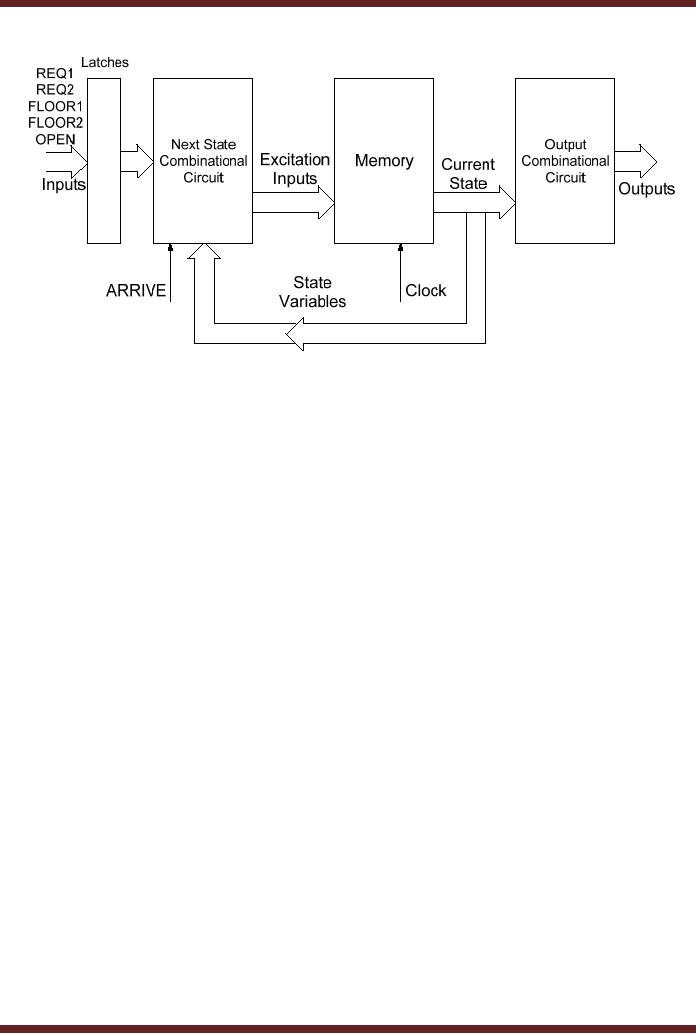
CS302 -
Digital Logic & Design
Figure
36.3 Block diagram of the
Elevator State
Machine
376
Table of Contents:
- AN OVERVIEW & NUMBER SYSTEMS
- Binary to Decimal to Binary conversion, Binary Arithmetic, 1’s & 2’s complement
- Range of Numbers and Overflow, Floating-Point, Hexadecimal Numbers
- Octal Numbers, Octal to Binary Decimal to Octal Conversion
- LOGIC GATES: AND Gate, OR Gate, NOT Gate, NAND Gate
- AND OR NAND XOR XNOR Gate Implementation and Applications
- DC Supply Voltage, TTL Logic Levels, Noise Margin, Power Dissipation
- Boolean Addition, Multiplication, Commutative Law, Associative Law, Distributive Law, Demorgan’s Theorems
- Simplification of Boolean Expression, Standard POS form, Minterms and Maxterms
- KARNAUGH MAP, Mapping a non-standard SOP Expression
- Converting between POS and SOP using the K-map
- COMPARATOR: Quine-McCluskey Simplification Method
- ODD-PRIME NUMBER DETECTOR, Combinational Circuit Implementation
- IMPLEMENTATION OF AN ODD-PARITY GENERATOR CIRCUIT
- BCD ADDER: 2-digit BCD Adder, A 4-bit Adder Subtracter Unit
- 16-BIT ALU, MSI 4-bit Comparator, Decoders
- BCD to 7-Segment Decoder, Decimal-to-BCD Encoder
- 2-INPUT 4-BIT MULTIPLEXER, 8, 16-Input Multiplexer, Logic Function Generator
- Applications of Demultiplexer, PROM, PLA, PAL, GAL
- OLMC Combinational Mode, Tri-State Buffers, The GAL16V8, Introduction to ABEL
- OLMC for GAL16V8, Tri-state Buffer and OLMC output pin
- Implementation of Quad MUX, Latches and Flip-Flops
- APPLICATION OF S-R LATCH, Edge-Triggered D Flip-Flop, J-K Flip-flop
- Data Storage using D-flip-flop, Synchronizing Asynchronous inputs using D flip-flop
- Dual Positive-Edge triggered D flip-flop, J-K flip-flop, Master-Slave Flip-Flops
- THE 555 TIMER: Race Conditions, Asynchronous, Ripple Counters
- Down Counter with truncated sequence, 4-bit Synchronous Decade Counter
- Mod-n Synchronous Counter, Cascading Counters, Up-Down Counter
- Integrated Circuit Up Down Decade Counter Design and Applications
- DIGITAL CLOCK: Clocked Synchronous State Machines
- NEXT-STATE TABLE: Flip-flop Transition Table, Karnaugh Maps
- D FLIP-FLOP BASED IMPLEMENTATION
- Moore Machine State Diagram, Mealy Machine State Diagram, Karnaugh Maps
- SHIFT REGISTERS: Serial In/Shift Left,Right/Serial Out Operation
- APPLICATIONS OF SHIFT REGISTERS: Serial-to-Parallel Converter
- Elevator Control System: Elevator State Diagram, State Table, Input and Output Signals, Input Latches
- Traffic Signal Control System: Switching of Traffic Lights, Inputs and Outputs, State Machine
- Traffic Signal Control System: EQUATION DEFINITION
- Memory Organization, Capacity, Density, Signals and Basic Operations, Read, Write, Address, data Signals
- Memory Read, Write Cycle, Synchronous Burst SRAM, Dynamic RAM
- Burst, Distributed Refresh, Types of DRAMs, ROM Read-Only Memory, Mask ROM
- First In-First Out (FIFO) Memory
- LAST IN-FIRST OUT (LIFO) MEMORY
- THE LOGIC BLOCK: Analogue to Digital Conversion, Logic Element, Look-Up Table
- SUCCESSIVE –APPROXIMATION ANALOGUE TO DIGITAL CONVERTER